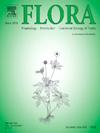Iron histolocalization in Amazon canga plants reveals phylogeny-driven adaptation strategies
IF 1.8
4区 生物学
Q3 ECOLOGY
引用次数: 0
Abstract
Iron (Fe) is an essential nutrient for plant growth and development; however, it can become toxic when present in excess in the plant tissues. This study examines the iron-regulating mechanisms in six species (three monocots and three eudicots) from three distinct canga physiognomies – open canga, grasslands, and shrublands – located in the iron-rich ecosystems of Serra dos Carajás, eastern Amazon (Brazil). Using histochemical analysis, scanning electron microscopy, and energy-dispersive X-ray spectroscopy, we examined iron absorption, translocation, and accumulation in root and leaf tissues. Our findings revealed phylogenetically driven strategies, with distinct responses between monocots and eudicots. In monocots, such as Axonopus carajasensis, iron exclusion was facilitated by iron plaque formation and a robust endodermis, while iron was accumulated in bundle sheath cells of leaves to prevent toxicity. Conversely, eudicots like Mimosa acutistipula accumulated iron in mesophyll cells, with phenolic compounds aiding in chelation and oxidative stress mitigation. Trichomes on the adaxial surfaces of Paspalum cangarum and Brasilianthus carajensis appeared to trap iron, potentially shielding the stomata from clogging. Furthermore, the formation of aerenchyma in monocot roots improved oxygen transport and facilitated iron plaque formation in waterlogged conditions. These distinct phylogenetic responses may contribute to the coexistence of plant species from different evolutionary lineages across the environmental gradients of canga. These adaptive strategies highlight the ecological success of canga species in iron-rich environments, allowing them to thrive in extreme conditions.

Amazon cana植物铁的组织定位揭示了系统发育驱动的适应策略
铁(Fe)是植物生长发育必需的营养物质;然而,当它在植物组织中过量存在时,它会变得有毒。本研究考察了巴西亚马逊东部Serra dos Carajás富铁生态系统中来自三种不同地貌(开放地貌、草原地貌和灌丛地貌)的六种物种(三种单子科植物和三种单子科植物)的铁调节机制。利用组织化学分析、扫描电镜和能量色散x射线光谱,我们研究了铁在根和叶组织中的吸收、转运和积累。我们的发现揭示了系统发育驱动的策略,在单子房和双子房之间有不同的反应。在单子叶植物中,如卡拉jasaxonopus,铁斑的形成和强健的内胚层促进了铁的排除,而铁在叶片的束鞘细胞中积累以防止毒性。相反,像含羞草这样的植物在叶肉细胞中积累铁,酚类化合物有助于螯合和氧化应激缓解。雀稗(Paspalum angarum)和巴西花(Brasilianthus carajensis)正面的毛状体似乎可以捕获铁,从而潜在地保护气孔不被堵塞。此外,在淹水条件下,单子叶根部的通气组织的形成改善了氧的运输,促进了铁斑块的形成。这些不同的系统发育反应可能有助于来自不同进化谱系的植物物种在坎加的环境梯度中共存。这些适应策略突出了cana物种在富铁环境中的生态成功,使它们能够在极端条件下茁壮成长。
本文章由计算机程序翻译,如有差异,请以英文原文为准。
求助全文
约1分钟内获得全文
求助全文
来源期刊

Flora
生物-植物科学
CiteScore
3.30
自引率
10.50%
发文量
130
审稿时长
54 days
期刊介绍:
FLORA publishes original contributions and review articles on plant structure (morphology and anatomy), plant distribution (incl. phylogeography) and plant functional ecology (ecophysiology, population ecology and population genetics, organismic interactions, community ecology, ecosystem ecology). Manuscripts (both original and review articles) on a single topic can be compiled in Special Issues, for which suggestions are welcome.
FLORA, the scientific botanical journal with the longest uninterrupted publication sequence (since 1818), considers manuscripts in the above areas which appeal a broad scientific and international readership. Manuscripts focused on floristics and vegetation science will only be considered if they exceed the pure descriptive approach and have relevance for interpreting plant morphology, distribution or ecology. Manuscripts whose content is restricted to purely systematic and nomenclature matters, to geobotanical aspects of only local interest, to pure applications in agri-, horti- or silviculture and pharmacology, and experimental studies dealing exclusively with investigations at the cellular and subcellular level will not be accepted. Manuscripts dealing with comparative and evolutionary aspects of morphology, anatomy and development are welcome.
 求助内容:
求助内容: 应助结果提醒方式:
应助结果提醒方式:


